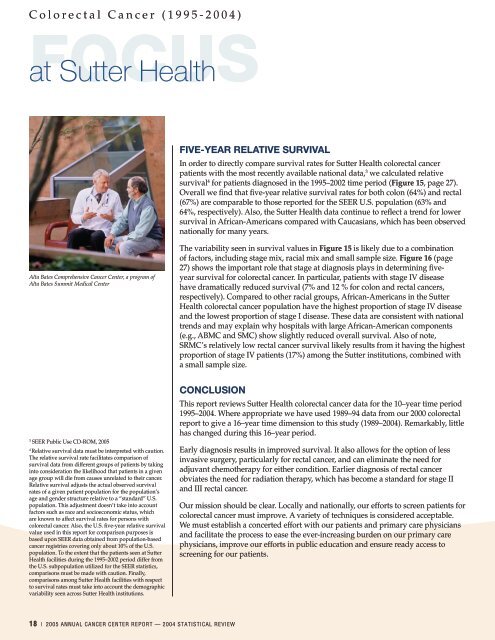Sutter Health Cancer Services and Programs
Sutter Health Cancer Services and Programs
Sutter Health Cancer Services and Programs
You also want an ePaper? Increase the reach of your titles
YUMPU automatically turns print PDFs into web optimized ePapers that Google loves.
C o l o r e c t a l C a n c e r ( 1 9 9 5 - 2 0 0 4 )FOCUSat <strong>Sutter</strong> <strong>Health</strong>Five-Year Relative SurvivalIn order to directly compare survival rates for <strong>Sutter</strong> <strong>Health</strong> colorectal cancerpatients with the most recently available national data, 3 we calculated relativesurvival 4 for patients diagnosed in the 1995–2002 time period (Figure 15, page 27).Overall we find that five-year relative survival rates for both colon (64%) <strong>and</strong> rectal(67%) are comparable to those reported for the SEER U.S. population (63% <strong>and</strong>64%, respectively). Also, the <strong>Sutter</strong> <strong>Health</strong> data continue to reflect a trend for lowersurvival in African-Americans compared with Caucasians, which has been observednationally for many years.Alta Bates Comprehensive <strong>Cancer</strong> Center, a program ofAlta Bates Summit Medical CenterThe variability seen in survival values in Figure 15 is likely due to a combinationof factors, including stage mix, racial mix <strong>and</strong> small sample size. Figure 16 (page27) shows the important role that stage at diagnosis plays in determining fiveyearsurvival for colorectal cancer. In particular, patients with stage IV diseasehave dramatically reduced survival (7% <strong>and</strong> 12 % for colon <strong>and</strong> rectal cancers,respectively). Compared to other racial groups, African-Americans in the <strong>Sutter</strong><strong>Health</strong> colorectal cancer population have the highest proportion of stage IV disease<strong>and</strong> the lowest proportion of stage I disease. These data are consistent with nationaltrends <strong>and</strong> may explain why hospitals with large African-American components(e.g., ABMC <strong>and</strong> SMC) show slightly reduced overall survival. Also of note,SRMC’s relatively low rectal cancer survival likely results from it having the highestproportion of stage IV patients (17%) among the <strong>Sutter</strong> institutions, combined witha small sample size.3SEER Public Use CD-ROM, 20054Relative survival data must be interpreted with caution.The relative survival rate facilitates comparison ofsurvival data from different groups of patients by takinginto consideration the likelihood that patients in a givenage group will die from causes unrelated to their cancer.Relative survival adjusts the actual observed survivalrates of a given patient population for the population’sage <strong>and</strong> gender structure relative to a “st<strong>and</strong>ard” U.S.population. This adjustment doesn’t take into accountfactors such as race <strong>and</strong> socioeconomic status, whichare known to affect survival rates for persons withcolorectal cancer. Also, the U.S. five-year relative survivalvalue used in this report for comparison purposes isbased upon SEER data obtained from population-basedcancer registries covering only about 10% of the U.S.population. To the extent that the patients seen at <strong>Sutter</strong><strong>Health</strong> facilities during the 1995–2002 period differ fromthe U.S. subpopulation utilized for the SEER statistics,comparisons must be made with caution. Finally,comparisons among <strong>Sutter</strong> <strong>Health</strong> facilities with respectto survival rates must take into account the demographicvariability seen across <strong>Sutter</strong> <strong>Health</strong> institutions.ConclusionThis report reviews <strong>Sutter</strong> <strong>Health</strong> colorectal cancer data for the 10–year time period1995–2004. Where appropriate we have used 1989–94 data from our 2000 colorectalreport to give a 16–year time dimension to this study (1989–2004). Remarkably, littlehas changed during this 16–year period.Early diagnosis results in improved survival. It also allows for the option of lessinvasive surgery, particularly for rectal cancer, <strong>and</strong> can eliminate the need foradjuvant chemotherapy for either condition. Earlier diagnosis of rectal cancerobviates the need for radiation therapy, which has become a st<strong>and</strong>ard for stage II<strong>and</strong> III rectal cancer.Our mission should be clear. Locally <strong>and</strong> nationally, our efforts to screen patients forcolorectal cancer must improve. A variety of techniques is considered acceptable.We must establish a concerted effort with our patients <strong>and</strong> primary care physicians<strong>and</strong> facilitate the process to ease the ever-increasing burden on our primary carephysicians, improve our efforts in public education <strong>and</strong> ensure ready access toscreening for our patients.18 | 2005 Annual <strong>Cancer</strong> Center Report — 2004 Statistical Review













